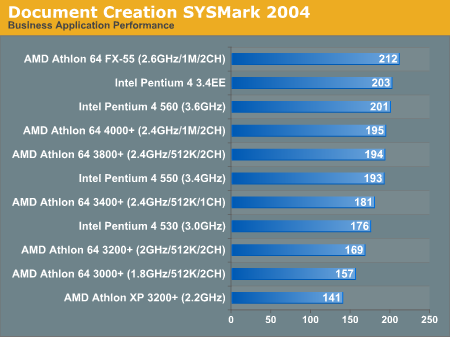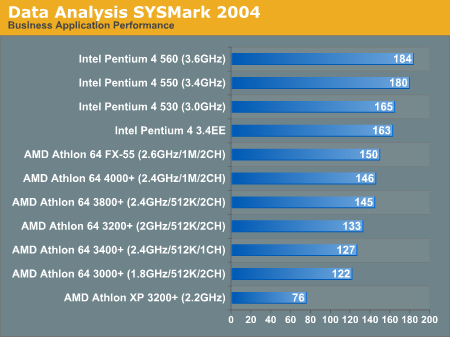AMD Athlon 64 4000+ & FX-55: A Thorough Investigation
by Anand Lal Shimpi on October 19, 2004 1:04 AM EST- Posted in
- CPUs
Business/General Use Performance
Business Winstone 2004
Business Winstone 2004 tests the following applications in various usage scenarios:
. Microsoft Access 2002
. Microsoft Excel 2002
. Microsoft FrontPage 2002
. Microsoft Outlook 2002
. Microsoft PowerPoint 2002
. Microsoft Project 2002
. Microsoft Word 2002
. Norton AntiVirus Professional Edition 2003
. WinZip 8.1
AMD has always dominated performance under business applications, which is why in the past they have always been known as a good CPU maker for office applications. Obviously with the K7 and K8 series of processors AMD changed the rules of the game a bit, offering top of the line performance in far more than just office applications. However, despite AMD's improvements in performance elsewhere, the Athlon 64 continues to hold on as the fastest processor for business applications.
Here we see that there is no performance difference between the three 2.4GHz parts, which is to be expected considering the relatively small datasets and correspondingly low bandwidth nature of business applications.
Even the entry level Athlon 64 3200+ is able to outperform Intel's top of the line Pentium 4 560 here. While Intel will argue that performance here doesn't matter, what does matter is that AMD is faster at a lower price point. Even the old Athlon XP 3200+ is able to offer performance similar to the Pentium 4 550.

Office Productivity SYSMark 2004
SYSMark's Office Productivity suite consists of three tests, the first of which is the Communication test. The Communication test consists of the following:
"The user receives an email in Outlook 2002 that contains a collection of documents in a zip file. The user reviews his email and updates his calendar while VirusScan 7.0 scans the system. The corporate web site is viewed in Internet Explorer 6.0. Finally, Internet Explorer is used to look at samples of the web pages and documents created during the scenario."
While the Athlon 64 FX-55 and 4000+ manage to land on top, it isn't by a huge margin. The FX-55 holds just under an 8% performance advantage over Intels Pentium 4 3.4EE. The Pentium 4 550 and Athlon 64 3800+ tie in the middle, while the 3400+ offers statistically similar performance.
What's interesting to note here is that the Athlon XP 3200+ manages to outperform, ever so slightly, the newer Athlon 64 3000+, thanks to a somewhat shorter pipeline and higher clock speed. What these results tell us is that the Communication test is much less dependent on the memory subsystem, rendering the on-die memory controller advantages of the Athlon 64 relatively useless. Our theories are confirmed by the fact that there's virtually no difference in performance in the single and dual channel memory configurations of the Athlon 64. There is, however, a boost in performance when going from a 512KB cache to a 1MB cache (3800+ -> 4000+), indicating that the datasets here are too big for a 512KB cache, but fit much better in a 1MB cache.
The Pentium 4 does relatively well here, with the Prescott based 90nm 560 offering similar performance to the Northwood based 130nm 3.4EE, with the higher clock speed able to make up for Prescott's other shortcomings.

The next test is Document Creation performance, which shows very little difference in drive performance between the contenders:
"The user edits the document using Word 2002. He transcribes an audio file into a document using Dragon NaturallySpeaking 6. Once the document has all the necessary pieces in place, the user changes it into a portable format for easy and secure distribution using Acrobat 5.0.5. The user creates a marketing presentation in PowerPoint 2002 and adds elements to a slide show template."
The inclusion of a speech recognition test as a part of this next benchmark immediately excludes the older generation of processors from being in the running for top performance spots. The lack of an on-die memory controller keeps the Athlon XP 3200+ at the end of the pack, while the more bandwidth friendly Pentium 4 and Athlon 64 platforms battle it out for the lead here.
The Athlon 64 FX-55 manages to secure a small 5% lead over the 3.4EE and the Pentium 4 560. It's not a noticeable performance lead in the real world, but it does stand on paper (or on web if you prefer). We once again see that there's no huge benefit to the 4000+'s 1MB L2 cache, but the dual channel configuration of our Socket-939 platforms clearly comes in handy, resulting in a 7% performance boost for the 3800+ over the single channel 3400+.

The final test in our Office Productivity suite is Data Analysis, which BAPCo describes as:
"The user opens a database using Access 2002 and runs some queries. A collection of documents are archived using WinZip 8.1. The queries' results are imported into a spreadsheet using Excel 2002 and are used to generate graphical charts."
Although not quite the enterprise level server database, MS Access does get used quite frequently in small to medium sized business environments to handle light database loads.
Here the Pentium 4s completely dominate, with the Prescott core truly extending the performance lead here. None of the AMD chips even stand a chance, not to mention the thrashing that the XP 3200+ gets. The Data Analysis tests do prove that despite the performance in other areas, there are a few pedestals that the Pentium 4 does continue to stand quite high upon.











89 Comments
View All Comments
skiboysteve - Tuesday, October 19, 2004 - link
On the Business winstone 2004..."The Pentium 4 550 and Athlon 64 3800+ tie in the middle, while the 3400+ offers statistically similar performance."
No they didnt.
microAmp - Tuesday, October 19, 2004 - link
Very nice article, loved the L2 cache and memory comparisons at the end.thermalpaste - Tuesday, October 19, 2004 - link
Way back in 2000, I felt that Intel was doing something stupid by introducing the Willamette.The thunderbird was faster than the p-III coppermine at the same clock speeds, but considering that the p-III just had 2 parallel FPUs compared to the 3 on the athlon. An additional FPU would have helped of course. though the P-III core was not able to sustain higher clock speeds , intel could have redesigned a marginally deeper pipeline on the same core rather than designing the pentium-4 with a mammoth 20 stage pipeline.
Now the prescotts come with a 30-odd stage pipeline, but the integer unit runs at twice the speed which doesn't make the 7th generation of processors from intel very 'scalable'. Besides the processor heats upto 70 odd degrees with consummate ease (Im staying in India where the avg. room temperature is something like 29 degrees Celsius) and is not overclocker friendly.
I am waiting for the newer chips from Intel, based on the Pentium-M a.k.a the P6 architecture.
AMD is way ahead of Intel as of now.
skiboysteve - Tuesday, October 19, 2004 - link
Athlon 64 4000+ - 2.4GHz - 1MB - 128-bitAthlon 64 3800+ - 2.4GHz - 512KB - 128-bit
Athlon 64 3400+ - 2.4GHz - 1MB - 64-bit
Athlon 64 3400+ - 2.4GHz - 512KB - 64-bit
Athlon 64 FX-53 - 2.4GHz - 1MB - 128-bit
these numbers look off.
Your saying there are two s754 3400+, and one has more cache?
eva2000 - Tuesday, October 19, 2004 - link
why leave out the 3700+ s754 1MB from suhc a nice comparison :)miketheidiot - Tuesday, October 19, 2004 - link
excellent article. I agree with #2 that I would have liked to see an overclocking comparison, or at least a quick demonstation of the 4000 and fx-55. Still a great article though.GhandiInstinct - Tuesday, October 19, 2004 - link
We can always marvel at them but the prices, realistcaly speaking is a waste of our time. I'm as interested in the FX-55 as much as the IBM super-computer blue.Zac42 - Tuesday, October 19, 2004 - link
I especially liked the comparrison of the equally priced value procs at the end of the article. Nice way to sum up the graphs. Good overall comparison, as you guys have just about any possible app one could use on a PC. Now we just need an OC comparrison, and we will be set!DrMrLordX - Tuesday, October 19, 2004 - link
Nice article so far, still reading it, but I would like to know where the 925XE chipset-based P4 board was in this review? Are those available to you guys yet? Just wondering.